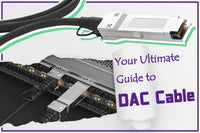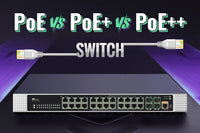Contents
Selecting the right transceiver is essential for effective network design. The choice between Small Form-factor Pluggable (SFP) and Enhanced Small Form-factor pluggable (SFP+) can greatly impact the overall network performance. Though both SFP and SFP+ transceivers can be used for data transmission, they offer different capabilities. Understanding the differences between SFP and SFP+ is key to optimizing your network infrastructure for better performance.
What is SFP?
The Small Form-factor Pluggable (SFP) transceiver was first introduced in 2001. It is a compact and hot-swappable transceiver used to connect network devices, including switches, routers, and network cards. As the successor of Gigabit Interface Converter (GBIC), it is also known as Mini-GBIC. The SFP ports on the switch and SFP modules allow for data transmitting and receiving over fiber optic and Ethernet cables. Built on the standard of Multi-Source Agreement (MSA), SFP modules ensure compatibility across network components from different manufacturers. Based on IEEE802.3 and SFF-8472, SFP modules are generally used for Gigabit and Fast Ethernet.
What is SFP+?
Small Form-Factor Pluggable Plus (SFP+), first introduced on May 9, 2006, is an enhanced version of SPF. Like its predecessor, SFP+ is also a hot-swappable and compact module for data transmission across different network devices. 10 Gbit/s SFP+ plays a crucial role in modern demanding network environments with its improved optical and electrical components. Fibre Channel protocol allows SFP+ to be used at the maximum data rate of 16 Gbps. SFP+ modules can be connected with Direct attach cables (DAC) for short-distance connections and paired with AOC (Active Optical cables) for longer transmission distances.
SFP vs. SFP+: What Are the Differences?
Though both SFP and SFP+ are designed to connect network devices for high-speed data rates, they differ in several aspects:
Date Rates
According to the SFF INF-8074i standard, a common SFP reaches a nominal speed of 1 Gbps, which is often used with Fast Ethernet (100 Mbps) and Gigabit Ethernet (1 Gbps) applications. Compared to SFP, SFP+ is designed to use for 10 Gigabit Ethernet and it is often used in data centers and other high-demanding environments.
Transmission Distances
Depending on the type of fiber, SFP and SFP+ travel different distances in different Fast Ethernet physical layers. The most common SFP transceiver use 850nm wavelength, which can support transmission distances of up to 500 meters with multi-mode fibers. The single-mode SFP modules can even reach a longer distance. SFP+ transceivers, for 10 Gbps, can transmit up to 300 meters with multi-mode fibers and to even 120 km with single-mode fibers, making them more ideal for connecting remote areas.
Power Consumption
SFP+ transceivers generally consume more power as they require more power to handle higher speeds and greater bandwidth. But their enhanced capabilities allow them to provide higher data rates with lower power consumption in the long run.
Protocols Supported
SFP: SFP supports protocols like Gigabit Ethernet, SONET (Synchronous Optical Networking), Fibre Channel, and other standards.
SFP+: Besides Gigabit Ethernet and Fibre Channel communications standards, SFP+ supports OTN (Optical Transport Network) standard OTU2 that transports an OC-192, STM-64, or wide area network (WAN) physical layer (PHY) for 10G Ethernet.
Compatibility
SFP+ offers greater compatibility because it can be backward compatible with SFP, XENPAK, and X2. SFP modules are compatible with managed or unmanaged converters, and PoE switches, and SFP+ is generally used with managed switches for the best performance. In many cases, SFP and SFP+ are interchangeable as they have a similar appearance.
|
SFP |
SFP+ |
|
|
Date Rates |
Lower |
Higher |
|
Transmission Distances |
Up to 100 km |
Up to 120 km |
|
Power Consumption |
Less |
More |
|
Protocols Supported |
Gigabit Ethernet, SONET (Synchronous Optical Networking), Fibre Channel |
OTN (Optical Transport Network) Standard OTU2 |
|
Compatibility |
Managed or Unmanaged Converters, PoE switches |
Backward Compatible with SFP, XENPAK, and X2 |
|
Fiber Type |
Single-mode Fiber, Multi-mode Fiber |
Single-mode Fiber, Multi-mode Fiber |
|
Wavelength |
850 - 1550nm CWDM/DWDM |
850 - 1550nm CWDM/DWDM |
SFP vs. SFP+: How to Choose?
To make the right choice, there are some factors that you need to consider.
First, you need to assess your requirements for network performance. SFP supports up to 1 Gbps data rates, suitable for small home and office networks. In contrast, SFP+ is capable of delivering a maximum speed of 16 Gbps in Fibre Channel applications, making it ideal for switch stacking, large-scale enterprise networks, and data centers. 10 Gbit/s SFP+ transceivers are particularly prevalent in large enterprise and telecommunications networks and other data-intensive applications.
You should also consider the compatibility with network devices. SFP and SFP+ can work seamlessly with most modern switches, routers, PoE switches, and media converters. SFP+ has a broader compatibility than SFP transceivers. Besides, you should also consider your budget as SFP+ can cost more.
The type of fiber optic cables is also a key factor for network performance. Generally, single-mode fiber optic cables are suitable for long-distance transmission, while multi-mode optical cables are used for shorter distances.
Other Types of Transceivers
There are some other common types of pluggable transceivers available on the market. Just read below.
- SFP28: SFP28 is an enhanced version of SFP+ but looks like SFP or SFP+. SFP28 was introduced on September 13, 2014, and complies with the SFF SFF-8402 standard. It has a 28 Gbps channel but mainly supports the data rate of 25 Gbps. SFP28 is widely used in 25G Ethernet and Common Public Radio Interface (CPRI).
- QSFP+: QSFP+was introduced on April 1, 2012, and follows the standard of SFF SFF-8436. QSFP+ is built on QSFP (Quad Small Form-factor Pluggable) but supports high-density 40G Ethernet. It provides four independent 10G channels for one 40G Ethernet connection or four separate 10G connections such as 10G Ethernet, 10G FiberChannel, or Quad Data Rate (QDR) InfiniBand. It is widely used in data centers and high-performance computing (HPC) and storage.
- QSFP28: QSFP28 was introduced on the same day as SFP28 and specified in the SFF SFF-8665 standard. QSFP28 provides four 28 Gbps channels but is mainly used for an aggregated 100 Gbps connection. The connection form can be 4x25G, 2x50G, or 1x100G.
Final Words
The main difference between SFP and SFP+ pluggable transceivers is their data rate. So, SFP is ideal for small to medium networks, while SFP+ is designed for more complex and dense networks. After knowing these differences, you should evaluate your desired network performance, costs, and compatibility with your network devices.
FAQs
1. Can I Connect SFP Modules to SFP+ Ports?
Yes, SFP modules can be plugged into SFP+ ports but will function with a data transmission speed of 1Gbps.
2. What Are the Differences between CWDM and DWDM SFP?
CWDM and DWDM technologies are used to increase bandwidth over the same fiber. CWDM SFP is less expensive and suitable for broader spacing between channels; while DWDM is suitable for denser spacing between channels.
3. Does SFP Support PoE?
No, SFP doesn’t support PoE. But a switch that supports PoE can provide power supply by connecting Ethernet cables to its combo SFP/electrical ports.
For more information on this topic, you can keep up on our blogs. While VCELINK offers general and basic information for our customers and other visitors to the website, it’s not professional advice.



Be the first one to comment.
Leave a comment